Launch Campaign Summary
12 December 1999
When so much effort has been devoted to XMM-Newton, designed to be operational for over ten years, and when the hopes and expectations of its astronomer users are so great, one can readily imagine that everything has been done to ensure reliability of the spacecraft and the success of the mission.
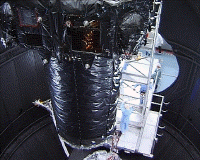 |
|
XMM-Newton lower module being lowered into the chamber of the Large Space Simulator (LSS) at ESTEC for thermal tests. |
As for many spacecraft, there was a two-step verification of XMM-Newton. During the first, the Structural and Thermal Model (STM) and the Electrical Model (EM) of the satellite were submitted to a variety of tests. Several of these tests took place in an environment tougher than the expected real conditions of space and launch. This constitutes the design qualification phase. When all the requirements were met, the programme concentrated on the flight model of the satellite. During its final integration, tests were once again been carried out, but in an acceptance phase. At this stage, the design was no longer in doubt; it was a question of ensuring that everything had been built according to the design that had been qualified, and that it was assembled properly.
Three kinds of environmental tests
There are three kinds of environmental tests on the spacecraft, its modules and science instruments.
- Thermal vacuum tests. The satellite or equipment was placed in a vacuum chamber with a sun simulator that reproduced the intensity of sunlight, which recreated the environment of space with its extreme variations in temperature.
- Vibration tests. The spacecraft was progressively shaken at different strengths on a 'shaker'. The conditions created were up to 25% more severe than those expected at lift-off. The spacecraft resonance was also measured to evaluate how its different parts would react to set frequencies, including those that it would probably encounter at launch.
- Acoustic tests. The complete spacecraft was submitted in a reverberating chamber to very intense noise similar to which it would encounter during launch.
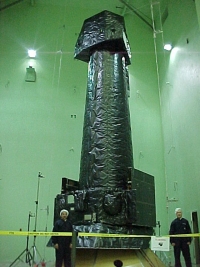 |
|
Fully assembled, XMM-Newton stands ten metres tall. It is shown here during acoustic testing at ESTEC in July 1999. |
The satellite's 'signature'
Testing was done in small increments. During a gentle shake, for instance, the satellite's behaviour or 'signature' was obtained. Then after having been shaken very hard, if that 'signature' was different with a repetition of the first shake, it could be a sign that something had become loose. Much as the ring of a bell will alter in pitch if it develops a hidden crack.
At various points during these environmental tests, use was made of computer-assisted simulations. The actual test results were compared to see whether the mathematical models were exact, and the models were updated if needed.
Electrical testing
The electrical tests verified the integrity of all the circuits aboard the satellite, but also the electromagnetic compatibility with the launcher and its ground installations. There is no question of having apparatus aboard the spacecraft creating interference that could jeopardise the launch. Compatibility tests were also conducted to verify that the internal electric circuits of the spacecraft did not interfere with each other.
All these tests upon XMM-Newton were carried out at different locations: ESTEC, one of the prime-contractor's facilities (Daimler Chrysler Dornier), the facilities of the suppliers of individual electronic equipment, and at various dedicated space environment and optical test facilities such as the Centre Spatial de Liège (CSL). Qualification and acceptance phases overlapped by about three months, but their total duration represents more than two years' work.
The spacecraft acceptance phase started in October 1998. As of May 1999, the fully assembled satellite at ESTEC was verified and the final testing lasted practically until the moment it was packed for its journey to Kourou.
Functional tests
The environmental tests that led up to launch do not constitute the whole story. What ensures in the first instance that a satellite will work properly in space as it has been conceived?
A myriad of functional tests accompanied each stage of development of each part of the spacecraft. "Boring details perhaps for the non-specialist, but tests that are again vital for the mission..." says Philippe Kletzkine, AIV and launch manager for XMM-Newton.
Key functional tests include:
- checking that electrical signals generated by one part of the spacecraft are received and understood where they are meant to be used
- testing the software that embodies operating modes, flight procedures and all the 'electronic cogs' of the spacecraft
- make sure the spacecraft sends the right information to the ground
- test that the received information is correctly processed
- the spacecraft is done correctly by the ground segment in order to control the spacecraft and execute the commands as expected
- make sure the spacecraft can navigate and point in the desired direction in space.
Checking that satellite and adapter fit
A crucial point during the launch takes places at the separation of the spacecraft. One of the tests at ESTEC required that the entire STM be placed on the Cylindrical Payload Adapter (ACU) to which the satellite will be attached on Ariane-5. This is termed a 'fit-check and release test' - although the spacecraft did not actually move away from the adapter.
The steel ring that holds the spacecraft ('clamp-band') was verified to ensure the dimensions and interfaces were right, and the pyrotechnic severing devices were fired, making sure the clamp-band opened unimpeded and recorded the resulting shocks upon XMM-Newton.
Big satellite, big transport headaches!
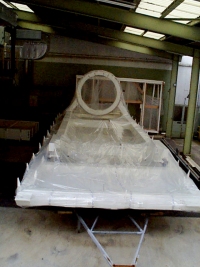 |
|
Chassis with the L-frame fully mounted. |
So, in early 1998, the decision was taken to ship the spacecraft in a giant container specially built for XMM-Newton. This container, built by APCO Vevey Switzerland, is 15 metres long, 4.5 metres wide and 4 metres high and when fully loaded weighs 24 tonnes.
The shipping story
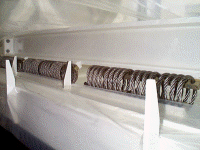 |
|
Spring units |
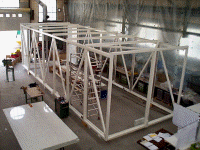 |
|
Cover frame for receiving the cladding panels with the first of the panels in place. |
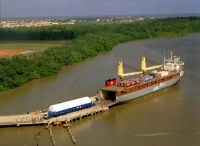 |
|
The Toucan during the unloading of an Ariane-5 main stage at Kourou (photo Arianespace) |
Arrival in Kourou
In preparation for its December launch XMM-Newton left ESTEC in mid-September and arrived in Kourou at the end of the month. Twelve weeks were required in French Guiana before the actual launch day to checkout the spacecraft and its scientific instruments, and to position and fit the last remaining elements, such as the spacecraft antennae and its telescope sunshield.
On its arrival at the European spaceport, XMM-Newton was taken to the Ariane-5 Final Assembly Building (BAF) where campaign operations took place. The BAF is located about three and a half kilometres from the launch area.
After unpacking the spacecraft, alignment tests were carried out (to verify that nothing had moved during transportation), the propulsion system was pressurised (to check for highly improbable leaks) and then the two stubby ten centimetre low-gain antennae were fitted at the end of their 60 centimetre booms.
 |
|
The Ariane-504 and the Final Assembly Building in Kourou where XMM-Newton spent its last days on Earth. |
Throughout transportation, launch preparation and the early orbital phase, the satellite optics remained covered. The sensitive mirror modules and optical monitor optics could not be exposed to the slightest contamination without jeopardising the mission. But an ultra-clean area (a class-100 tent) was available in the BAF. if required.
After the all the preparations were complete, the spacecraft was fuelled. This very delicate operation lasted several days because 530 kg of hydrazine was pumped into the satellite's tanks. These were pressurised with helium.
XMM-Newton scientific instruments were then verified. A vacuum was created in all the cameras. All the thermal blankets, opened to access certain parts of the satellite, were refastened, and some 'red-tag' items not required for the flight were removed.
Launch Campaign
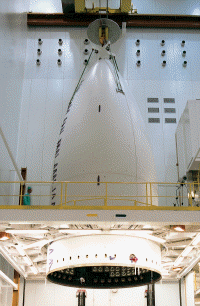 |
|
The Ariane-5 fairing, which protects XMM-Newton during the flight, seen in the Final Assembly Building. |
One major part of the satellite was positioned on D-14. The installation of the XMM-Newton sunshield required particular attention because of the confined space available between the satellite and the launcher. When everything was in place, on D-11, the Ariane-5 fairing was lowered and fastened and the precious passenger was hidden from view.
The satellite's final days on Earth
The satellite was then purged using synthetic air (a mixture of pure nitrogen and pure oxygen) and a flow of only nitrogen. Radio-frequency tests took place, to check that all the satellite telemetry was being received correctly. The spacecraft batteries were then conditioned and charged in a very precise way to maximise their capacity and life. More checkouts, a few last 'red-tag' items were withdrawn and XMM-Newton and its campaign team were ready for the D-3 launch rehearsal.
The last chance to access the satellite was on D-2: electrical protections ('safe-plugs') that interrupt certain circuits were removed, and replaced with 'flight-plugs'. XMM-Newton was armed and put on stand-by for lift-off, its last two days on Earth were dictated by the launch vehicle's own preparations.
Including the staff from the ESTEC's XMM-Newton programme team and the prime contractor Dornier and its subcontractors, about 40/50 people were involved in French Guiana. The campaign was supervised by Philippe Kletzkine, XMM-Newton AIV manager and by Daniel Biederman, Arianespace XMM-Newton Mission Manager.
